Bloom Clock/Keys/New Hampshire/July/All
The plants pictured below have been recorded as blooming during the month of July in New Hampshire.
Achillea millefolium
 Wikipedia • Commons • Wikibooks (horticulture) • Wikibooks (subject) • Wikispecies • Fruit and seed clock |
Profile for Achillea millefolium (Common Yarrow)
Recent Logs[edit | edit source]
TristanDolciano *˜˜˜12:00, 22 July 2019 (UTC) | ||||||||||
Global data:
Temperate zone season(s): Late Spring, Early Summer, Mid Summer, Late Summer, Early Fall, Mid Fall, Late Fall
Aralia hispida
 Wikipedia • Commons • Wikibooks (horticulture) • Wikibooks (subject) • Wikispecies • Fruit and seed clock |
Profile for Aralia hispida (Bristly Spikenard, Bristly Sarsaparilla)
Recent Logs[edit | edit source]
| ||||||||
Global data:
Temperate zone season(s): Early Summer, Mid Summer, Late Summer, Early Fall
Asclepias incarnata
 Wikipedia • Commons • Wikibooks (horticulture) • Wikibooks (subject) • Wikispecies • Fruit and seed clock |
Profile for Asclepias incarnata (Swamp Milkweed)
Recent Logs[edit | edit source]
| ||||||||||||
Global data:
Temperate zone season(s): Early Summer, Mid Summer, Late Summer
Asclepias syriaca
 Wikipedia • Commons • Wikibooks (horticulture) • Wikibooks (subject) • Wikispecies • Fruit and seed clock |
Profile for Asclepias syriaca (Common Milkweed)
Recent Logs[edit | edit source]
| ||
Global data:
Temperate zone season(s): Early Summer, Mid Summer
Aster novae-angliae
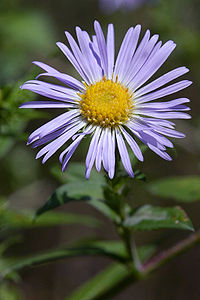 Wikipedia • Commons • Wikibooks (horticulture) • Wikibooks (subject) • Wikispecies • Fruit and seed clock |
Profile for Aster novae-angliae (New England Aster)
Recent Logs[edit | edit source]
| ||||||||||
Global data:
Temperate zone season(s): Early Summer, Mid Summer, Late Summer, Early Fall, Mid Fall, Late Fall
Calystegia sepium
 Wikipedia • Commons • Wikibooks (horticulture) • Wikibooks (subject) • Wikispecies • Fruit and seed clock |
Profile for Calystegia sepium (Hedge Bindweed)
Recent Logs[edit | edit source]
| ||||||||||
Global data:
Temperate zone season(s): Mid Summer, Late Summer, Early Fall
Chelidonium majus
 Wikipedia • Commons • Wikibooks (horticulture) • Wikibooks (subject) • Wikispecies • Fruit and seed clock |
Profile for Chelidonium majus (Greater Celandine)
Recent Logs[edit | edit source]
| ||||||||
Global data:
Temperate zone season(s): Mid Spring, Late Spring, Early Summer, Mid Summer, Late Summer, Early Fall
Chenopodium album
 Wikipedia • Commons • Wikibooks (horticulture) • Wikibooks (subject) • Wikispecies • Fruit and seed clock |
Profile for Chenopodium album (Lambsquarters, Goosefoot)
Recent Logs[edit | edit source]
| ||||||||
Global data:
Temperate zone season(s): Mid Summer, Late Summer, Early Fall, Mid Fall, Late Fall
Chimaphila umbellata
 Wikipedia • Commons • Wikibooks (horticulture) • Wikibooks (subject) • Wikispecies • Fruit and seed clock |
Profile for Chimaphila umbellata (Pipsissewa)
Recent Logs[edit | edit source]
| ||||||||||
Global data:
Temperate zone season(s): Mid Summer
Cicuta maculata
 Wikipedia • Commons • Wikibooks (horticulture) • Wikibooks (subject) • Wikispecies • Fruit and seed clock |
Profile for Cicuta maculata (Spotted Water Hemlock)
Recent Logs[edit | edit source]
| ||||||||||||||||||||
Global data:
Temperate zone season(s): Mid Summer, Late Summer
Dalibarda repens
 Wikipedia • Commons • Wikibooks (horticulture) • Wikibooks (subject) • Wikispecies • Fruit and seed clock |
Profile for Dalibarda repens (Dewdrop, Robin Runaway)
Recent Logs[edit | edit source]
| ||||||||||||
Global data:
Temperate zone season(s): Early Summer, Mid Summer, Late Summer
Daucus carota
 Wikipedia • Commons • Wikibooks (horticulture) • Wikibooks (subject) • Wikispecies • Fruit and seed clock |
Profile for Daucus carota (Carrot, Queen Anne's Lace)
Recent Logs[edit | edit source]
| ||||||||||
Global data:
Temperate zone season(s): Early Summer, Mid Summer, Late Summer, Early Fall, Mid Fall
Dianthus armeria
 Wikipedia • Commons • Wikibooks (horticulture) • Wikibooks (subject) • Wikispecies • Fruit and seed clock |
Profile for Dianthus armeria (Deptford Pink)
Recent Logs[edit | edit source]
| ||
Global data:
Temperate zone season(s): Early Summer, Mid Summer, Late Summer, Early Fall, Mid Fall
Erigeron annuus
 Wikipedia • Commons • Wikibooks (horticulture) • Wikibooks (subject) • Wikispecies • Fruit and seed clock |
Profile for Erigeron annuus (Fleabane)
Recent Logs[edit | edit source]
| ||||||||
Global data:
Temperate zone season(s): Late Spring, Early Summer, Mid Summer, Late Summer
Eriocaulon aquaticum
 Wikipedia • Commons • Wikibooks (horticulture) • Wikibooks (subject) • Wikispecies • Fruit and seed clock |
Profile for Eriocaulon aquaticum (Pipewort)
Recent Logs[edit | edit source]
| ||||||||||||||
Global data:
Temperate zone season(s): Mid Summer, Late Summer
Eupatorium perfoliatum
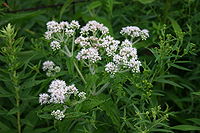 Wikipedia • Commons • Wikibooks (horticulture) • Wikibooks (subject) • Wikispecies • Fruit and seed clock |
Profile for Eupatorium perfoliatum (Boneset)
Recent Logs[edit | edit source]
| ||||||||
Global data:
Fragaria vesca
 Wikipedia • Commons • Wikibooks (horticulture) • Wikibooks (subject) • Wikispecies • Fruit and seed clock |
Profile for Fragaria vesca (Woodland Strawberry)
Recent Logs[edit | edit source]
| ||
Global data:
Temperate zone season(s): Mid Spring, Late Spring, Late Summer, Early Fall
Frangula alnus
 Wikipedia • Commons • Wikibooks (horticulture) • Wikibooks (subject) • Wikispecies • Fruit and seed clock |
Profile for Frangula alnus (Glossy Buckthorn)
Recent Logs[edit | edit source] | ||||||||||||
Global data:
Temperate zone season(s): Early Summer, Mid Summer
Galium triflorum
 Wikipedia • Commons • Wikibooks (horticulture) • Wikibooks (subject) • Wikispecies • Fruit and seed clock |
Profile for Galium triflorum (Fragrant Bedstraw)
Recent Logs[edit | edit source]
| ||||||||||||
Global data:
Temperate zone season(s): Early Summer, Mid Summer, Late Summer, Early Fall, Mid Fall, Late Fall
Gaultheria procumbens
 Wikipedia • Commons • Wikibooks (horticulture) • Wikibooks (subject) • Wikispecies • Fruit and seed clock |
Profile for Gaultheria procumbens (Eastern Teaberry, Checkerberry, Boxberry and American Wintergreen)
Recent Logs[edit | edit source]
| ||||||||||||||||||
Global data:
Temperate zone season(s): Mid Summer, Late Summer
Hemerocallis
 Wikipedia • Commons • Wikibooks (horticulture) • Wikibooks (subject) • Wikispecies • Fruit and seed clock |
Profile for Hemerocallis (Daylily)
Recent Logs[edit | edit source]
| ||||||||||
Global data:
Temperate zone season(s): Early Summer, Mid Summer, Late Summer, Early Fall
Hosta
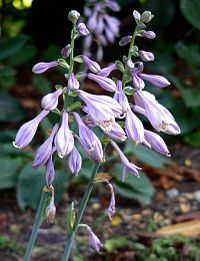 Wikipedia • Commons • Wikibooks (horticulture) • Wikibooks (subject) • Wikispecies • Fruit and seed clock |
Profile for Hosta (Hosta)
Recent Logs[edit | edit source]
| ||||||||||
Global data:
Temperate zone season(s): Early Summer, Late Summer, Late Summer, Early Fall
Houstonia caerulea
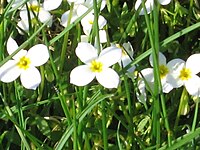 Wikipedia • Commons • Wikibooks (horticulture) • Wikibooks (subject) • Wikispecies • Fruit and seed clock |
Profile for Houstonia caerulea (Azure Bluet)
Recent Logs[edit | edit source]
| ||||||||||||||||
Global data:
Temperate zone season(s): Mid Spring, Late Spring, Early Summer, Mid Summer
Hydrangea macrophylla
 Wikipedia • Commons • Wikibooks (horticulture) • Wikibooks (subject) • Wikispecies • Fruit and seed clock |
Profile for Hydrangea macrophylla (Bigleaf Hydrangea)
Recent Logs[edit | edit source]
| ||||||
Global data:
Temperate zone season(s): Early Summer, Mid Summer, Late Summer, Early Fall, Mid Fall
Hypericum perforatum
 Wikipedia • Commons • Wikibooks (horticulture) • Wikibooks (subject) • Wikispecies • Fruit and seed clock |
Profile for Hypericum perforatum (St. John's wort)
Recent Logs[edit | edit source]
| ||||||||||||||
Global data:
Temperate zone season(s): Early Summer, Mid Summer, Late Summer, Early Fall, Mid Fall
Kalmia angustifolia
 Wikipedia • Commons • Wikibooks (horticulture) • Wikibooks (subject) • Wikispecies • Fruit and seed clock |
Profile for Kalmia angustifolia (Sheep-laurel)
Recent Logs[edit | edit source]
| ||||||||
Global data:
Temperate zone season(s): Early Summer, Mid Summer
Lepidium virginicum
 Wikipedia • Commons • Wikibooks (horticulture) • Wikibooks (subject) • Wikispecies • Fruit and seed clock |
Profile for Lepidium virginicum (Virginia pepperweed)
Recent Logs[edit | edit source] | ||||||||||||||||
Global data:
Temperate zone season(s): Early Summer, Mid Summer, Late Summer, Early Fall, Mid Fall, Late Fall
Leucanthemum vulgare
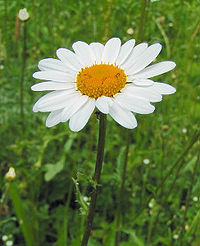 Wikipedia • Commons • Wikibooks (horticulture) • Wikibooks (subject) • Wikispecies • Fruit and seed clock |
Profile for Leucanthemum vulgare (Oxeye Daisy)
Recent Logs[edit | edit source]
| ||||||||
Global data:
Temperate zone season(s): Late Spring, Early Summer, Mid Summer
Linaria vulgaris
 Wikipedia • Commons • Wikibooks (horticulture) • Wikibooks (subject) • Wikispecies • Fruit and seed clock |
Profile for Linaria vulgaris (Butter and Eggs)
Recent Logs[edit | edit source]
| ||||||||||||||||
Global data:
Temperate zone season(s): Late Spring, Early Summer, Mid Summer, Late Summer, Mid Fall, Late Fall
Lotus corniculatus
 Wikipedia • Commons • Wikibooks (horticulture) • Wikibooks (subject) • Wikispecies • Fruit and seed clock |
Profile for Lotus corniculatus (Birdsfoot Trefoil)
Recent Logs[edit | edit source]
| ||||||||||||||
Global data:
Temperate zone season(s): Late Spring, Early Summer, Mid Summer, Late Summer, Early Fall, Mid Fall
Lysimachia ciliata
 Wikipedia • Commons • Wikibooks (horticulture) • Wikibooks (subject) • Wikispecies • Fruit and seed clock |
Profile for Lysimachia ciliata (Fringed Loosestrife)
Recent Logs[edit | edit source]
| ||
Global data:
Temperate zone season(s): Early Summer, Mid Summer, Late Summer
Lysimachia quadrifolia
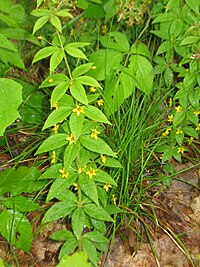 Wikipedia • Commons • Wikibooks (horticulture) • Wikibooks (subject) • Wikispecies • Fruit and seed clock |
Profile for Lysimachia quadrifolia (Whorled Loosestrife)
Recent Logs[edit | edit source]
| ||||||||||||||
Global data:
Temperate zone season(s): Early Summer, Mid Summer, Late Summer
Lysimachia terrestris
 Wikipedia • Commons • Wikibooks (horticulture) • Wikibooks (subject) • Wikispecies • Fruit and seed clock |
Profile for Lysimachia terrestris (Swamp Candles)
Recent Logs[edit | edit source]
| ||||||||||||||||
Global data:
Temperate zone season(s): Mid Summer, Late Summer
Lythrum salicaria
 Wikipedia • Commons • Wikibooks (horticulture) • Wikibooks (subject) • Wikispecies • Fruit and seed clock |
Profile for Lythrum salicaria (Purple Loosestrife)
Recent Logs[edit | edit source] | ||||||||
Global data:
Temperate zone season(s): Early Summer, Mid Summer, Late Summer, Early Fall
Matricaria discoidea
 Wikipedia • Commons • Wikibooks (horticulture) • Wikibooks (subject) • Wikispecies • Fruit and seed clock |
Profile for Matricaria discoidea (Pineappleweed)
Recent Logs[edit | edit source]
| ||||||||||||||||
Global data:
Temperate zone season(s): Late Spring, Early Summer, Mid Summer
Medeola virginiana
 Wikipedia • Commons • Wikibooks (horticulture) • Wikibooks (subject) • Wikispecies • Fruit and seed clock |
Profile for Medeola virginiana (Indian cucumber-root)
Recent Logs[edit | edit source]
| ||||||||||||||||
Global data:
Temperate zone season(s): Early Summer, Mid Summer
Melampyrum lineare
 Wikipedia • Commons • Wikibooks (horticulture) • Wikibooks (subject) • Wikispecies • Fruit and seed clock |
Profile for Melampyrum lineare (Cow-wheat)
Recent Logs[edit | edit source]
| ||||||||||||
Global data:
Temperate zone season(s): Early Summer, Mid Summer, Late Summer
Melilotus alba
 Wikipedia • Commons • Wikibooks (horticulture) • Wikibooks (subject) • Wikispecies • Fruit and seed clock |
Profile for Melilotus alba (White Sweet Clover)
Recent Logs[edit | edit source]
| ||||||||||||
Global data:
Temperate zone season(s): Early Summer, Mid Summer, Late Summer, Early Fall, Mid Fall
Mitchella repens
 Wikipedia • Commons • Wikibooks (horticulture) • Wikibooks (subject) • Wikispecies • Fruit and seed clock |
Profile for Mitchella repens (Partridge Berry)
Recent Logs[edit | edit source]
| ||||||||||||||
Global data:
Temperate zone season(s): Early Summer, Mid Summer
Mollugo verticillata
 Wikipedia • Commons • Wikibooks (horticulture) • Wikibooks (subject) • Wikispecies • Fruit and seed clock |
Profile for Mollugo verticillata (Carpetweed)
Recent Logs[edit | edit source]
| ||||||||||||
Global data:
Temperate zone season(s): Early Summer, Mid Summer, Late Summer, Early Fall, Mid Fall
Monotropa uniflora
 Wikipedia • Commons • Wikibooks (horticulture) • Wikibooks (subject) • Wikispecies • Fruit and seed clock |
Profile for Monotropa uniflora (Indian Pipe)
Recent Logs[edit | edit source]
| ||||||||||||||||||
Global data:
Temperate zone season(s): Early Summer, Mid Summer, Late Summer, Early Fall
Myosotis
 Wikipedia • Commons • Wikibooks (horticulture) • Wikibooks (subject) • Wikispecies • Fruit and seed clock |
Profile for Myosotis (Forget-me-not)
Recent Logs[edit | edit source]--Anna gdf 11:24, 11 May 2010 (UTC) | ||||||
Global data:
Temperate zone season(s): Late Spring, Early Summer, Mid Summer, Late Summer
Nuphar variegata
 Wikipedia • Commons • Wikibooks (horticulture) • Wikibooks (subject) • Wikispecies • Fruit and seed clock |
Profile for Nuphar variegata (Bullhead Lily, Yellow Pond Lily)
Recent Logs[edit | edit source]
| ||||||||
Global data:
Temperate zone season(s): Late Spring, Early Summer, Mid Summer, Late Summer
Nuttallanthus canadensis
 Wikipedia • Commons • Wikibooks (horticulture) • Wikibooks (subject) • Wikispecies • Fruit and seed clock |
Profile for Nuttallanthus canadensis (Blue Toadflax)
Recent Logs[edit | edit source]
| ||||||||||||
Global data:
Temperate zone season(s): Mid Summer, Late Summer
Nymphaea odorata
 Wikipedia • Commons • Wikibooks (horticulture) • Wikibooks (subject) • Wikispecies • Fruit and seed clock |
Profile for Nymphaea odorata (White Water Lily)
Recent Logs[edit | edit source]
| ||||||||||||||||
Global data:
Temperate zone season(s): Early Summer, Mid Summer, Late Summer
Nymphoides cordata
 Wikipedia • Commons • Wikibooks (horticulture) • Wikibooks (subject) • Wikispecies • Fruit and seed clock |
Profile for Nymphoides cordata (Floating Heart)
Recent Logs[edit | edit source]
| ||||||||||||||
Global data:
Temperate zone season(s): Mid Summer, Late Summer
Oxalis stricta
 Wikipedia • Commons • Wikibooks (horticulture) • Wikibooks (subject) • Wikispecies • Fruit and seed clock |
Profile for Oxalis stricta (Common Yellow Woodsorrel)
Recent Logs[edit | edit source]
| ||||||||||||||
Global data:
Temperate zone season(s): Mid Spring, Late Spring, Early Summer, Mid Summer, Late Summer, Early Fall, Mid Fall, Late Fall
Phytolacca americana
 Wikipedia • Commons • Wikibooks (horticulture) • Wikibooks (subject) • Wikispecies • Fruit and seed clock |
Profile for Phytolacca americana (Pokeweed)
Recent Logs[edit | edit source]
| ||||||
Global data:
Temperate zone season(s): Early Summer, Mid Summer, Late Summer, Early Fall, Mid Fall
Plantago lanceolata
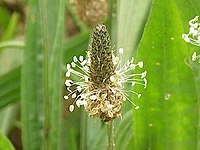 Wikipedia • Commons • Wikibooks (horticulture) • Wikibooks (subject) • Wikispecies • Fruit and seed clock |
Profile for Plantago lanceolata (Ribwort Plantain)
Recent Logs[edit | edit source]--Anna reg 20:54, 29 April 2010 (UTC)
| ||||||||||||
Global data:
Temperate zone season(s): Late Spring, Early Summer, Mid Summer, Late Summer, Early Fall, Mid Fall
Plantago major
 Wikipedia • Commons • Wikibooks (horticulture) • Wikibooks (subject) • Wikispecies • Fruit and seed clock |
Profile for Plantago major (Broadleaf Plantain)
Recent Logs[edit | edit source]
| ||||||||||
Global data:
Temperate zone season(s): Early Summer, Mid Summer, Late Summer
Polygonum pensylvanicum
 Wikipedia • Commons • Wikibooks (horticulture) • Wikibooks (subject) • Wikispecies • Fruit and seed clock |
Profile for Polygonum pensylvanicum (Pennsylvania Smartweed)
Recent Logs[edit | edit source]
| ||||||||||||||
Global data:
Pontederia cordata
 Wikipedia • Commons • Wikibooks (horticulture) • Wikibooks (subject) • Wikispecies • Fruit and seed clock |
Profile for Pontederia cordata (Pickerelweed)
Recent Logs[edit | edit source]
| ||||||||||||||||
Global data:
Potentilla arguta
 Wikipedia • Commons • Wikibooks (horticulture) • Wikibooks (subject) • Wikispecies • Fruit and seed clock |
Profile for Potentilla arguta (Tall Cinquefoil)
Recent Logs[edit | edit source]
| ||||||||||||
Global data:
Temperate zone season(s): Early Summer, Mid Summer, Late Summer, Early Fall
Potentilla canadensis
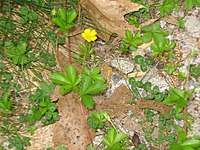 Wikipedia • Commons • Wikibooks (horticulture) • Wikibooks (subject) • Wikispecies • Fruit and seed clock |
Profile for Potentilla canadensis (Dwarf Cinquefoil)
Recent Logs[edit | edit source] | ||||||||||||
Global data:
Prunella vulgaris
 Wikipedia • Commons • Wikibooks (horticulture) • Wikibooks (subject) • Wikispecies • Fruit and seed clock |
Profile for Prunella vulgaris (Self-heal, Heal-all)
Recent Logs[edit | edit source]
| ||||||||||
Global data:
Temperate zone season(s): Early Summer, Mid Summer, Mid Fall
Pyrola
 Wikipedia • Commons • Wikibooks (horticulture) • Wikibooks (subject) • Wikispecies • Fruit and seed clock |
Profile for Pyrola (Pyrola)
Recent Logs[edit | edit source]
| ||||||||||
Global data:
Ranunculus
 Wikipedia • Commons • Wikibooks (horticulture) • Wikibooks (subject) • Wikispecies • Fruit and seed clock |
Profile for Ranunculus (Buttercup)
Recent Logs[edit | edit source]
| ||||
Global data:
Temperate zone season(s): Early Spring, Mid Spring
Rhus typhina
 Wikipedia • Commons • Wikibooks (horticulture) • Wikibooks (subject) • Wikispecies • Fruit and seed clock |
Profile for Rhus typhina (Staghorn Sumac)
Recent Logs[edit | edit source]
| ||||||||||||
Global data:
Temperate zone season(s): Early Summer
Robinia pseudoacacia
 Wikipedia • Commons • Wikibooks (horticulture) • Wikibooks (subject) • Wikispecies • Fruit and seed clock |
Profile for Robinia pseudoacacia (Black Locust)
Recent Logs[edit | edit source]
| ||
Global data:
Temperate zone season(s): Late Spring
Rosa
 Wikipedia • Commons • Wikibooks (horticulture) • Wikibooks (subject) • Wikispecies • Fruit and seed clock |
Profile for Rosa (Rose)
Recent Logs[edit | edit source]
| ||||||||||||||
Global data:
Temperate zone season(s): Late Spring, Early Summer, Mid Summer, Late Summer, Early Fall Mid Fall, Late Fall
Rubus pensilvanicus
 Wikipedia • Commons • Wikibooks (horticulture) • Wikibooks (subject) • Wikispecies • Fruit and seed clock |
Profile for Rubus pensilvanicus (Blackberry)
Recent Logs[edit | edit source]
| ||
Global data:
Temperate zone season(s): Late Spring, Early Summer
Rumex acetosella
 Wikipedia • Commons • Wikibooks (horticulture) • Wikibooks (subject) • Wikispecies • Fruit and seed clock |
Profile for Rumex acetosella (Sheepsorrel)
Recent Logs[edit | edit source]
| ||||||||||||
Global data:
Temperate zone season(s): Late Spring, Early Summer
Rumex crispus
 Wikipedia • Commons • Wikibooks (horticulture) • Wikibooks (subject) • Wikispecies • Fruit and seed clock |
Profile for Rumex crispus (Curly Dock)
Recent Logs[edit | edit source]
| ||
Global data:
Temperate zone season(s): Early Summer, Mid Summer, Late Summer, Early Fall
Sagittaria graminea
 Wikipedia • Commons • Wikibooks (horticulture) • Wikibooks (subject) • Wikispecies • Fruit and seed clock |
Profile for Sagittaria graminea (Grassy Arrowhead)
Recent Logs[edit | edit source]
| ||||||||||||||
Global data:
Sambucus canadensis
 Wikipedia • Commons • Wikibooks (horticulture) • Wikibooks (subject) • Wikispecies • Fruit and seed clock |
Profile for Sambucus canadensis (American Elderberry)
Recent Logs[edit | edit source]
| ||
Global data:
Temperate zone season(s): Early Summer, Mid Summer
Saponaria officinalis
 Wikipedia • Commons • Wikibooks (horticulture) • Wikibooks (subject) • Wikispecies • Fruit and seed clock |
Profile for Saponaria officinalis (Soapwort)
Recent Logs[edit | edit source]
| ||||||||
Global data:
Temperate zone season(s): Late Spring, Early Summer, Mid Summer, Late Summer, Early Fall, Mid Fall
Schoenoplectus tabernaemontani
 Wikipedia • Commons • Wikibooks (horticulture) • Wikibooks (subject) • Wikispecies • Fruit and seed clock |
Profile for Schoenoplectus tabernaemontani (Softstem Bulrush)
Recent Logs[edit | edit source]
| ||||||||||||||||
Global data:
Temperate zone season(s): Mid Summer, Late Summer
Silene latifolia
 Wikipedia • Commons • Wikibooks (horticulture) • Wikibooks (subject) • Wikispecies • Fruit and seed clock |
Profile for Silene latifolia (White Campion)
Recent Logs[edit | edit source]
| ||
Global data:
Temperate zone season(s): Late Spring, Early Summer, Mid Summer
Silene vulgaris
 Wikipedia • Commons • Wikibooks (horticulture) • Wikibooks (subject) • Wikispecies • Fruit and seed clock |
Profile for Silene vulgaris (Bladder Campion)
Recent Logs[edit | edit source]
| ||
Global data:
Solanum dulcamara
 Wikipedia • Commons • Wikibooks (horticulture) • Wikibooks (subject) • Wikispecies • Fruit and seed clock |
Profile for Solanum dulcamara (Bittersweet, Bitter Nightshade, Blue Bindweed, Climbing Nightshade)
Recent Logs[edit | edit source]
| ||||||||||||
Global data:
Temperate zone season(s): Early Summer, Mid Summer, Late Summer, Early Fall, Mid Fall
Solidago
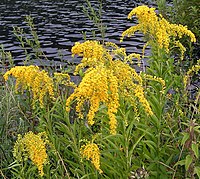 Wikipedia • Commons • Wikibooks (horticulture) • Wikibooks (subject) • Wikispecies • Fruit and seed clock |
Profile for Solidago (Goldenrod)
Recent Logs[edit | edit source]
| ||||
Global data:
Temperate zone season(s): Late Summer, Early Fall, Mid Fall, Late Fall, Early Winter
Solidago canadensis
 Wikipedia • Commons • Wikibooks (horticulture) • Wikibooks (subject) • Wikispecies • Fruit and seed clock |
Profile for Solidago canadensis (Canada Goldenrod)
Recent Logs[edit | edit source]
| ||||||||||||
Global data:
Spergularia
 Wikipedia • Commons • Wikibooks (horticulture) • Wikibooks (subject) • Wikispecies • Fruit and seed clock |
Profile for Spergularia (Sandspurry)
Recent Logs[edit | edit source]
| ||||||||||||||
Global data:
Temperate zone season(s): Late Spring, Early Summer, Mid Summer, Late Summer, Early Fall
Spiraea japonica
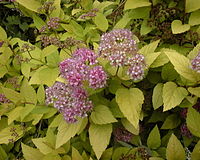 Wikipedia • Commons • Wikibooks (horticulture) • Wikibooks (subject) • Wikispecies • Fruit and seed clock |
Profile for Spiraea japonica (Japanese Spiraea)
Recent Logs[edit | edit source]
| ||||||||
Global data:
Temperate zone season(s): Early Summer, Mid Summer, Late Summer, Early Fall, Mid Fall
Taraxacum officinale
 Wikipedia • Commons • Wikibooks (horticulture) • Wikibooks (subject) • Wikispecies • Fruit and seed clock |
Profile for Taraxacum officinale (Common Dandelion)
Recent Logs[edit | edit source]
| ||||||||||||||||||
Global data:
Temperate zone season(s): Mid Winter, Late Winter, Early Spring, Mid Spring, Late Spring, Early Summer, Mid Summer, Late Summer, Early Fall, Mid Fall, Late Fall, Early Winter
Tilia americana
 Wikipedia • Commons • Wikibooks (horticulture) • Wikibooks (subject) • Wikispecies • Fruit and seed clock |
Profile for Tilia americana (Basswood)
Recent Logs[edit | edit source]
| ||
Global data:
Temperate zone season(s): Early Summer, Mid Summer
Tradescantia
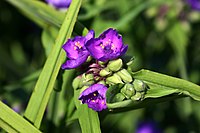 Wikipedia • Commons • Wikibooks (horticulture) • Wikibooks (subject) • Wikispecies • Fruit and seed clock |
Profile for Tradescantia (Spiderwort)
2009 Logs[edit | edit source]=====Recent Logs===== | ||||||||||
Global data:
Temperate zone season(s): Late Spring, Early Summer, Mid Summer, Late Summer
Trifolium arvense
 Wikipedia • Commons • Wikibooks (horticulture) • Wikibooks (subject) • Wikispecies • Fruit and seed clock |
Profile for Trifolium arvense (Rabbit's-foot Clover)
Recent Logs[edit | edit source]
| ||||||||
Global data:
Temperate zone season(s): Early Summer, Mid Summer, Mid Fall
Trifolium aureum
 Wikipedia • Commons • Wikibooks (horticulture) • Wikibooks (subject) • Wikispecies • Fruit and seed clock |
Profile for Trifolium aureum (Hop Clover)
Recent Logs[edit | edit source]
| ||||||||||||||
Global data:
Trifolium pratense
 Wikipedia • Commons • Wikibooks (horticulture) • Wikibooks (subject) • Wikispecies • Fruit and seed clock |
Profile for Trifolium pratense (Red Clover)
Recent Logs[edit | edit source]
| ||||||||||
Global data:
Temperate zone season(s): Late Spring, Early Summer, Mid Summer, Late Summer, Early Fall, Mid Fall, Late Fall
Trifolium repens
 Wikipedia • Commons • Wikibooks (horticulture) • Wikibooks (subject) • Wikispecies • Fruit and seed clock |
Profile for Trifolium repens (White Clover)
Recent Logs[edit | edit source]
| ||||||||||
Global data:
Temperate zone season(s): Late Spring, Early Summer, Mid Summer, Late Summer, Early Fall, Mid Fall
Verbascum thapsus
 Wikipedia • Commons • Wikibooks (horticulture) • Wikibooks (subject) • Wikispecies • Fruit and seed clock |
Profile for Verbascum thapsus (Mullein)
Recent Logs[edit | edit source]
| ||||||||||
Global data:
Temperate zone season(s): Early Summer, Mid Summer, Late Summer, Early Fall
Verbena hastata
 Wikipedia • Commons • Wikibooks (horticulture) • Wikibooks (subject) • Wikispecies • Fruit and seed clock |
Profile for Verbena hastata (Vervain)
Recent Logs[edit | edit source]
| ||||||||||
Global data:
Veronica officinalis
 Wikipedia • Commons • Wikibooks (horticulture) • Wikibooks (subject) • Wikispecies • Fruit and seed clock |
Profile for Veronica officinalis (Heath Speedwell)
Recent Logs[edit | edit source] | ||||||||||||
Global data:
Vicia cracca
 Wikipedia • Commons • Wikibooks (horticulture) • Wikibooks (subject) • Wikispecies • Fruit and seed clock |
Profile for Vicia cracca (Tufted Vetch)
Recent Logs[edit | edit source]
| ||
Global data:
Temperate zone season(s): Late Spring, Early Summer, Mid Summer, Late Summer, Early Fall, Mid Fall, Late Fall
Viola tricolor
 Wikipedia • Commons • Wikibooks (horticulture) • Wikibooks (subject) • Wikispecies • Fruit and seed clock |
Profile for Viola tricolor (Heartsease, Johnny-jump-up)
Recent Logs[edit | edit source]
| ||
Global data:
Temperate zone season(s): Early Summer, Mid Summer, Late Summer, Early Fall, Mid Fall
